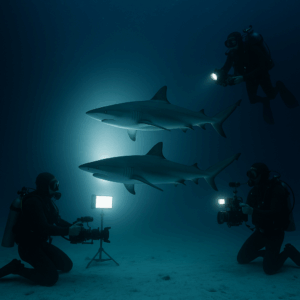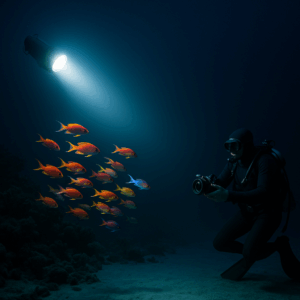Underwater cinematography is an increasingly sophisticated discipline that requires innovative lighting solutions to overcome its unique challenges. The inherent visual complexity of underwater environments presents a myriad of technical obstacles. These range from light absorption and scattering caused by water itself, to dynamic movement of aquatic life and the shifting play of natural light underwater. High-quality lighting is essential for capturing sharp, vibrant images that maintain fidelity across varying depths and water conditions.
Historically, underwater filmmakers relied primarily on traditional lighting technologies such as High-Intensity Discharge lamps (HID) like Hydrargyrum Medium-arc Iodide (HMI) lights and halogen lamps. While these sources provided intense illumination, they were often bulky, fragile, power-hungry, and produced considerable heat. Their spectral output was limited, leading to color distortions and inefficient energy use. Furthermore, the operational logistics of using such heavy lights in underwater scenarios often restricted creative flexibility.
The advent of Light Emitting Diode (LED) technology has revolutionized many fields, and underwater cinematography is no exception. Modern LED lighting systems bring compactness, robustness, and energy efficiency that far exceed those of traditional sources. Among these innovations, the 2000W underwater LED emerges as a game-changing technology, offering unprecedented luminous output, spectral control, and engineering designed specifically for challenging aquatic environments. This post delves deep into why the 2000W LED is setting new benchmarks in underwater lighting for cinema and beyond.
Understanding why high-performance lighting is critical underwater begins with physics. When light penetrates a water column, it is subject to absorption and scattering phenomena that alter its intensity, color, and directionality.
Absorption and Scattering: Water molecules and suspended particles absorb certain wavelengths of light and scatter others. Shorter wavelengths (blue and green) penetrate deeper, whereas longer wavelengths (red, orange, yellow) are rapidly absorbed, disappearing within just a few meters. This results in underwater scenes dominated by blue-green hues, posing a challenge to filmmakers aiming for natural color reproduction.
Wavelength Loss and Color Fidelity: As depth increases, the loss of red and warm tones impairs accurate color rendition, causing subjects to appear washed out or unnatural. Filmmakers must compensate with lighting that has sufficient intensity and precise spectral qualities to restore these colors effectively.
Importance of High-Lumen Output: To overcome the rapid attenuation of light underwater, a lighting source must deliver a very high lumen output, ensuring enough photons reach the camera sensor or film stock at varying depths and water clarities.
Spectral Accuracy: Beyond brightness, spectral accuracy—how well the light replicates natural colors—is paramount. Inaccurate lighting can cause skin tones to look unnatural and distort textures, undermining visual storytelling.
The 2000W LED addresses these issues by delivering a powerful, spectrally accurate output tailored for the aquatic environment, enabling filmmakers to reproduce scenes with stunning realism.
The choice of a 2000W LED unit represents a technical leap in underwater lighting performance. Here’s a breakdown of its core advantages:
Output Power and Luminous Efficacy: A 2000W LED fixture typically produces up to 320,000 lumens with an efficacy around 160 lumens per watt (lm/W). This level of brightness is unmatched by smaller LED fixtures or traditional lighting sources at similar power levels, enabling strong illumination of wide underwater scenes or distant subjects.
Penetration in Turbid Waters: Natural bodies of water rarely offer crystal-clear visibility. Suspended sediments, plankton, or other particulates cause turbidity, scattering and absorbing light. The sheer output power of 2000W LEDs improves penetration capacity, helping to maintain scene brightness and detail even in murky or low-light conditions.
Beam Angle and Luminance Uniformity: Cinematographers require control over beam spread to suit the narrative and spatial requirements of a shot. The 2000W LED allows for precise engineering of beam angles — from narrow spot beams for focused subject lighting to wide flood beams for illuminating large set areas. Furthermore, these units are designed to maintain luminance uniformity across the beam, avoiding hotspots or dark edges that could compromise image quality.
Together, these attributes make the 2000W LED a versatile lighting tool adaptable to various underwater production needs.
High-end underwater cinematography demands impeccable color accuracy to ensure natural skin tones and authentic representation of underwater flora and fauna.
Understanding TLCI and CRI: The Television Lighting Consistency Index (TLCI) and Color Rendering Index (CRI) are standardized metrics to quantify light source quality in terms of color fidelity.
The 2000W underwater LED fixtures deliver TLCI and CRI ratings of 95 or greater, ensuring minimal color distortion.
Importance for Underwater Skin Tones and Textures: Underwater subjects often include human performers whose natural skin tones must remain believable despite ambient water color shifts. The high TLCI/CRI rating ensures that subtle variations in skin tones, fabric colors, and surface textures are captured authentically, reducing post-production correction efforts.
Use Cases: Such color accuracy is vital across professional domains — from feature films and documentaries striving for realism, to high-end advertising requiring aesthetic perfection.
One of the most compelling features of modern 2000W LED underwater lights is their full-spectrum control, including RGB channels alongside variable white light.
Benefits of Tunable RGB + White Systems:
Dynamic Lighting Effects: This feature supports not only realistic scene illumination but also stylized productions requiring dramatic lighting shifts, such as underwater fashion shoots or music videos.

Delivering 2000W of light underwater requires sophisticated engineering to ensure reliability, safety, and operational durability.
Waterproofing and Pressure Tolerance: These fixtures typically boast an IP68+ rating, signifying they are fully submersible and can withstand depths of up to 25 meters (approximately 82 feet). This rating ensures no ingress of water or dust even under substantial pressure.
Corrosion-Resistant Materials: To survive harsh aquatic environments, the housing and fasteners use marine-grade anodized aluminum and stainless steel. These materials resist corrosion from saltwater and chemical exposure, extending the product lifespan and reducing maintenance.
Thermal Management: High-power LEDs generate heat that must be effectively dissipated, especially underwater where convective cooling is different than in air. The fixtures integrate both passive cooling (heat sinks, conductive materials) and active cooling (circulating water or specialized heat exchangers) to maintain stable operating temperatures and prevent thermal degradation.
Such engineering excellence guarantees continuous, reliable performance in demanding underwater filming scenarios.
Versatility in mounting and control is crucial for seamless integration into underwater production workflows.
Mounting Options:
Control Systems:
This flexibility allows cinematographers to adapt quickly to shifting scene requirements, improving creative efficiency.

The 2000W LED underwater light has already proven itself across various high-profile productions.
Feature Films: Underwater sequences requiring naturalistic daylight simulation and precise control benefit from the fixture’s power and color accuracy, enabling extended shooting hours without fatigue-inducing heat or unreliable output.
Music Videos and Fashion Shoots: Stylized underwater scenes use the RGB modulation capabilities for vibrant color effects that enhance mood and narrative impact.
Documentaries: Realistic lighting reveals the textures and colors of marine life, enhancing educational and conservation messaging.
Enhancing Mood and Subject Separation: The ability to control beam angles and intensity allows cinematographers to highlight key subjects, create depth, and sculpt scenes with light, all crucial for storytelling underwater.
Compared to traditional underwater lighting sources, 2000W LEDs offer significant operational advantages.
Energy Efficiency: With an efficacy of 160 lm/W, LEDs convert electrical power to visible light far more efficiently than HMIs or tungsten halogen lamps, which typically have lower efficacy rates.
Reduced Heat Output: Lower heat generation improves safety and comfort for divers and reduces the need for bulky cooling systems.
Power Supply Flexibility: The fixtures are compatible with battery packs, generators, or AC power, facilitating operations in remote locations without extensive infrastructure.
Sustainability: Reduced fuel consumption and longer operational hours align with the growing eco-consciousness in film production, minimizing environmental impact.
The 2000W underwater LED represents a transformative leap in underwater cinematography lighting technology. Combining immense luminous power, spectral precision, advanced engineering, and operational versatility, it addresses the long-standing challenges of underwater filming with unprecedented efficacy.
By delivering TLCI/CRI ratings above 95, broad color control via RGB + White modulation, and rugged design for deep submersion, it empowers filmmakers to capture stunning underwater visuals with natural colors, nuanced textures, and dramatic effects previously difficult or impossible to achieve.
As underwater cinematography continues to evolve, pushing creative boundaries and technical innovation, the 2000W LED fixture stands poised to become the new standard for high-end aquatic lighting — a critical tool in redefining the cinematic experience below the surface.
–The End–
Get in touch for free lighting customization